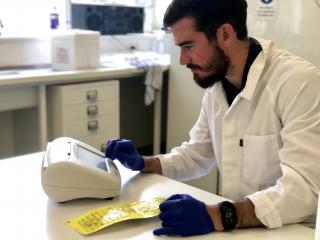An early warning system to detect the canola disease Turnip yellows virus (TuYV) has been developed, which will help to protect crop yields and profitability.
TuYV, previously known as Beet western yellow virus, can significantly affect crop potential, with a severe outbreak on the south coast in 2018 reducing yields by as much as 46 per cent.
The TuYV Early Warning System, developed as part of a Department of Primary Industries and Regional Development Flagship project, will be profiled at the Grains Research and Development Corporation’s (GRDC) Grains Research Updates at the end of the month.
The system utilises Loop-mediated isothermal AMPlification (LAMP) technology to detect TuYV in winged migratory aphids on yellow sticky traps.
Research officer Ben Congdon said the system would enable growers to detect TuYV before it became established at high levels and insecticide treatments were required.
“We developed a LAMP assay protocol that can detect a single TuYV-carrying aphid in large numbers of other aphids caught on sticky traps,” Dr Congdon said.
“In 2017 and 2018, this protocol was field validated at 30 sites across the grainbelt, by attaching traps to fences prior to sowing to catch aphids and testing these for TuYV by LAMP.
“The results showed that regular TuYV detection in winged aphids during a six week period from emergence to the five-leaf stage was a strong predictor for subsequent epidemic-level virus spread in the crop.”
Dr Congdon said the TuYV Early Warning System would assist growers to implement moretimely, efficient and cost effective virus disease management strategies.
“Severe TuYV epidemics are likely to become more frequent in the future due to high volume of canola sown, early sowing, high susceptibility of commercial cultivars, variable efficacy of neonicotinoid seed dressings and the ever-increasing risk of insecticide resistance in green peach aphids,” he said.
“Effective post-sowing control is limited to the application of systemic insecticides, such as sulfoxaflor, so the TuYV Early Warning System will assist the strategic and judicious use of treatments.”
The department will continue to test the system at high risk locations between Albany and Esperance during 2019.
Growers and advisers are encouraged to take advantage of the early warning system by obtaining free yellow sticky traps from the department’s Diagnostic Laboratory Services before seeding and submitting samples for LAMP testing at no charge.
For more details email ddls@dpird.wa.gov.au or telephone +61 (0) 8 9368 3351.
The 2019 GRDC Grains Research Update will be held in Perth on Monday 25 and Tuesday 26 February, while Regional Updates are scheduled for Albany and Geraldton. For details click here.

Media contacts: Jodie Thomson/Megan Broad, media liaison +61 (0)8 9368 3937
